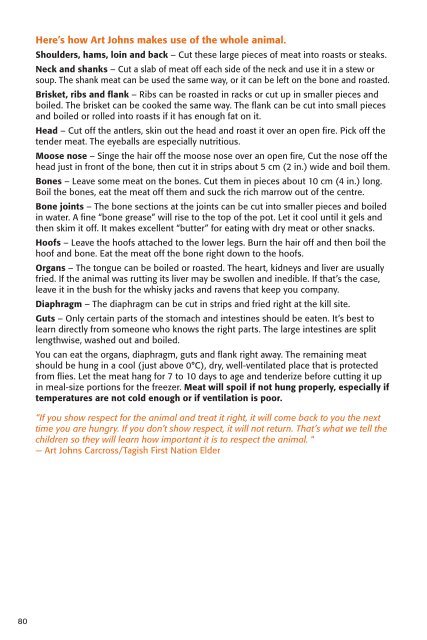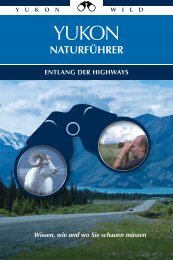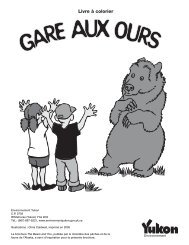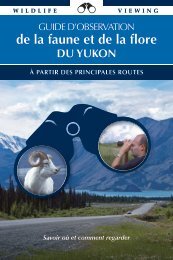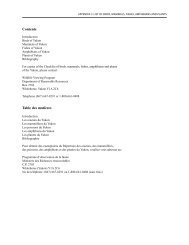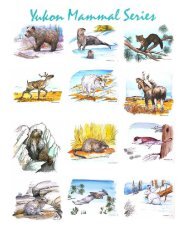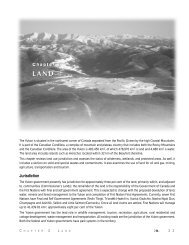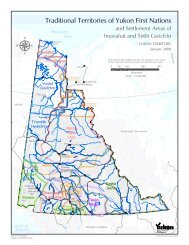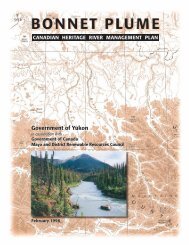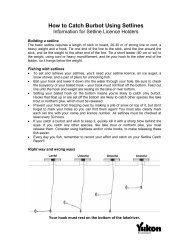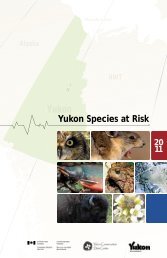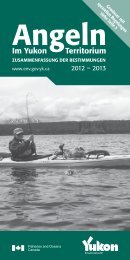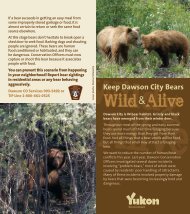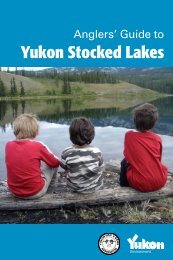Yukon Hunting - Department of Environment - Government of Yukon
Yukon Hunting - Department of Environment - Government of Yukon
Yukon Hunting - Department of Environment - Government of Yukon
Create successful ePaper yourself
Turn your PDF publications into a flip-book with our unique Google optimized e-Paper software.
80<br />
Here’s how Art Johns makes use <strong>of</strong> the whole animal.<br />
Shoulders, hams, loin and back – Cut these large pieces <strong>of</strong> meat into roasts or steaks.<br />
Neck and shanks – Cut a slab <strong>of</strong> meat <strong>of</strong>f each side <strong>of</strong> the neck and use it in a stew or<br />
soup. The shank meat can be used the same way, or it can be left on the bone and roasted.<br />
Brisket, ribs and flank – Ribs can be roasted in racks or cut up in smaller pieces and<br />
boiled. The brisket can be cooked the same way. The flank can be cut into small pieces<br />
and boiled or rolled into roasts if it has enough fat on it.<br />
Head – Cut <strong>of</strong>f the antlers, skin out the head and roast it over an open fire. Pick <strong>of</strong>f the<br />
tender meat. The eyeballs are especially nutritious.<br />
Moose nose – Singe the hair <strong>of</strong>f the moose nose over an open fire, Cut the nose <strong>of</strong>f the<br />
head just in front <strong>of</strong> the bone, then cut it in strips about 5 cm (2 in.) wide and boil them.<br />
Bones – Leave some meat on the bones. Cut them in pieces about 10 cm (4 in.) long.<br />
Boil the bones, eat the meat <strong>of</strong>f them and suck the rich marrow out <strong>of</strong> the centre.<br />
Bone joints – The bone sections at the joints can be cut into smaller pieces and boiled<br />
in water. A fine “bone grease” will rise to the top <strong>of</strong> the pot. Let it cool until it gels and<br />
then skim it <strong>of</strong>f. It makes excellent “butter” for eating with dry meat or other snacks.<br />
Ho<strong>of</strong>s – Leave the ho<strong>of</strong>s attached to the lower legs. Burn the hair <strong>of</strong>f and then boil the<br />
ho<strong>of</strong> and bone. Eat the meat <strong>of</strong>f the bone right down to the ho<strong>of</strong>s.<br />
Organs – The tongue can be boiled or roasted. The heart, kidneys and liver are usually<br />
fried. If the animal was rutting its liver may be swollen and inedible. If that’s the case,<br />
leave it in the bush for the whisky jacks and ravens that keep you company.<br />
Diaphragm – The diaphragm can be cut in strips and fried right at the kill site.<br />
Guts – Only certain parts <strong>of</strong> the stomach and intestines should be eaten. It’s best to<br />
learn directly from someone who knows the right parts. The large intestines are split<br />
lengthwise, washed out and boiled.<br />
You can eat the organs, diaphragm, guts and flank right away. The remaining meat<br />
should be hung in a cool (just above 0°C), dry, well-ventilated place that is protected<br />
from flies. Let the meat hang for 7 to 10 days to age and tenderize before cutting it up<br />
in meal-size portions for the freezer. Meat will spoil if not hung properly, especially if<br />
temperatures are not cold enough or if ventilation is poor.<br />
“If you show respect for the animal and treat it right, it will come back to you the next<br />
time you are hungry. If you don’t show respect, it will not return. That’s what we tell the<br />
children so they will learn how important it is to respect the animal. “<br />
— Art Johns Carcross/Tagish First Nation Elder


